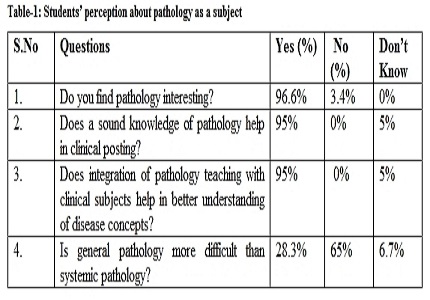A survey study based on undergraduate medical students’ feedback regarding pathology and the teaching-learning methodologies employed
Abstract
Background: It cannot be emphasized enough that a solid understanding of pathology is the foundation for a good clinical practice. And, Pathology, being a vast subject with the number of lecture hours being limited, understanding the students’ perspective is essential for generating interest in the subject and for gaining essential knowledge and skills during those limited hours assigned.
Aim: This study was aimed at understanding the students’ perspective regarding pathology as a subject and about the effectiveness of the various teaching-learning methods currently used by the faculty of our department.
Materials & Methods: This study was carried out on 81 2nd MBBS students (regular batch) who have completed 3 semesters of pathology using a predesigned questionnaire with questions pertaining to students’ perception of pathology and the various teaching learning methods currently used by the faculty.
Results: A vast majority of the students, 96.6%, found pathology to be an interesting subject. About 95% of them agreed that a sound knowledge of pathology was useful during their clinical postings and for their clinical practice. Majority of the students, 76.6%, were satisfied with content of the lectures taken. 93.3% of them felt that enough stress has been laid on important topics during the lecture classes and important points have been highlighted adequately. Popular modes of teaching learning were case-based discussions and group discussion (96.6 %), Powerpoint presentations (88%), black board teaching (78.3 %), integrated teaching ( 83.3%). 96.65% of the students agreed that written exams were a very effective assessment tool. Among the changes suggested by the students, the point most mentioned was that more practical exams and monthly tests need to be conducted because pathology was perceived as a vast subject. Lack of effective teacher-student communication was also mentioned in 6% of the feedback forms.
Conclusion: Our study showed that most students had a positive attitude towards pathology as a subject as well as the various teaching learning methods employed by the faculty of our department. Most students felt case based discussions and integrated teaching to be among the most effective ways of gaining knowledge.
Downloads
References
2. Domizio P. 12 The Changing Role of Pathology in the Undergraduate Curriculum. In: Hall PA, Wright NA, editors. Understanding Disease: A centenary celebration of the Pathological Society. London: Wiley; 2006. p. 137-52.
3. Dick F, Leaven T, Dillman D, Torner R, Finken L. Core morphological concepts of disease for second-year medical students. Hum Pathol. 1998 Sep;29(9):1017-20. [PubMed]
4. Herrmann FE, Lenski M, Steffen J, Kailuweit M, Nikolaus M, Koteeswaran R, et al. A survey study on student preferences regarding pathology teaching in Germany: A call for curricular modernization. BMC Medical Education 2015;15(1):94.
5. Khan S, Husain M. Students' feedback: An effective tool in teachers' evaluation system. International Journal of Applied and Basic Medical Research. 2016;6(3):178.
6. Quadri S, Srujana S, Mahesh S, Bheeshma B. Undergraduate medical students’ feedback and perceptions on teaching learning methodology in Pathology at Government Medical College. International archives of integrated medicine. 2016;3(7):28-35.
7. Goyal M, Bansal M, Gupta A, Yadav D. Perceptions and suggestions of 2nd professional MBBS students about their teaching and learning process: An analytical study. National journal of integrated research in medicine. 2010;1(4):20-24.
8. Rafique N. Introducing integrated practical examination for 2nd year MBBS class. 7th GCC Medical Colleges Conference. Dammam,Saudi Arabia: Saudi society of Family and Community medicine; 2009.
9. Woltering V, Herrler A, Spitzer K, Spreckelsen C. Blended learning positively affects students' satisfaction and the role of the tutor in the problem-based learning process: results of a mixed-method evaluation. Adv Health Sci Educ Theory Pract. 2009 Dec;14(5):725-38. doi: 10.1007/s10459-009-9154-6. Epub 2009 Jan 30.
10. Gray K, Tobin J. Introducing an online community into a clinical education setting: a pilot study of student and staff engagement and outcomes using blended learning. BMC Med Educ. 2010 Jan 26;10:6. doi: 10.1186/1472-6920-10-6.
11. Back DA, Haberstroh N, Sostmann K, Schmidmaier G, Putzier M, Perka C, et al. High efficacy and students' satisfaction after voluntary vs mandatory use of an e-learning program in traumatology and orthopedics — A follow-up study. Journal of Surgical Education 2014;71(1):353-9.
12. Masie E. Blended learning: The magic is in the mix. In: Rossett A, editor. The ASTD E-Learning Handbook. New York: McGraw-Hill; 2002. p. 58-63.
13. Ben-David FM. Association of Medical Education in Europe guide no. 14: outcome-based education: part 3- assessment in outcome-based education. Medical Teacher. 1999;21(1):23–25.
14. Amin TT, Kaliyan F, Al-Muhaidib NS. Medical students’ assessment preferences at King Faisal University, Saudi Arabia. Advances in Medical Education and Practice. 2011;2(1):95–103.
15. Epstein RM. Assessment in medical education. New England Journal of Medicine. 2007;356(1):387–96.
16. Dissanayake AS, Ali BA, Nayar U. The influence of the introduction of objective structures practical examinations in physiology on student performance at King Faisal University Medical School. Medical Teacher. 1990;12(1) :297–304.
17. Rahman N, Ferdousi S, Hoq N, Amin R, Kabir J. Evaluation of objective structured practical examination and traditional practical examination. Mymensingh Medical Journal. 2007;16(1) :7–11.
18. Htwe TT, Sabaridah I, Low GK. Comparative assessment of students’ performance and perceptions on objective structured practical models in undergraduate pathology teaching. Singapore Medical Journal. 2014;55(9):502–505.
19. Bellodi, Patrícia Lacerda. Mentors, students, and the undergraduate medical course: a virtuous circle. Revista Brasileira de Educação Médica, 2011; 35(3), 382-388.



 OAI - Open Archives Initiative
OAI - Open Archives Initiative


